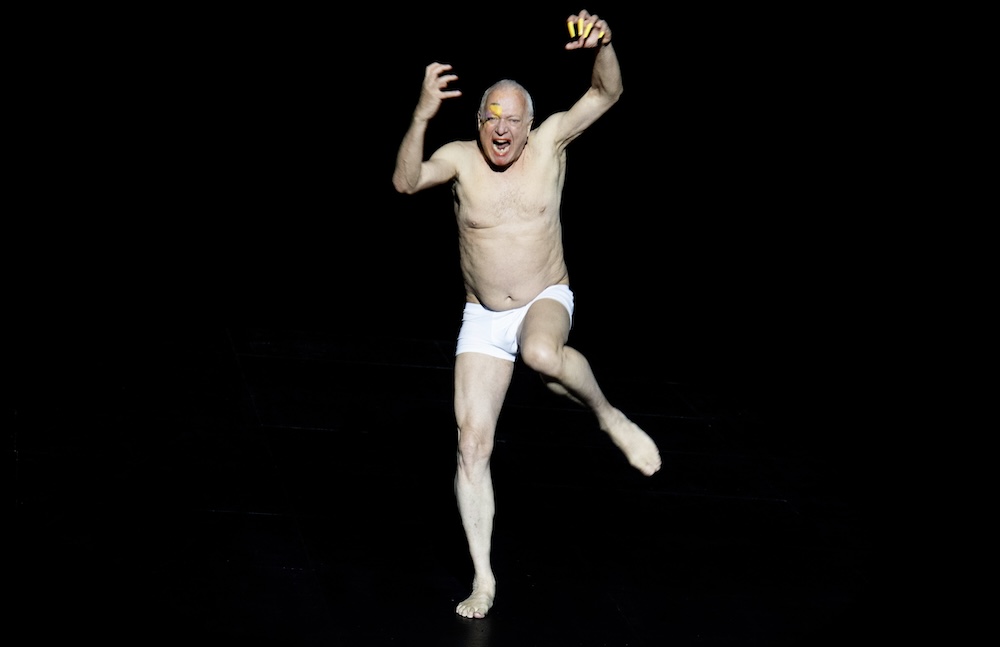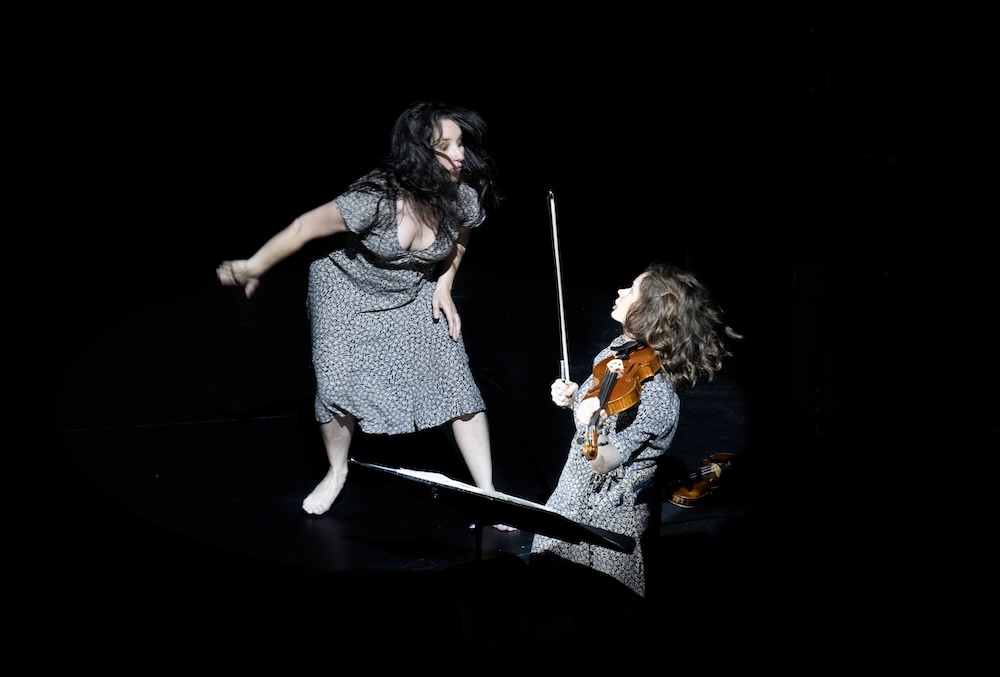That’s Eight Songs for a Mad King (1969) by Peter Maxwell Davies and Kafka-Fragmente (1987) by György Kurtág, an inspired pairing by Pierre Audi, the artistic director of the Aix Festival who directed György Kurtág’s only opera Fin de Partie (Beckett’s Endgame) for La Scala and Dutch National Opera in 2018.
A violin unites the two pieces. The seventh song of Davies’ monodrama instructs the singer to smash a violin. The Kafka-Fragmente — 40 brief statements from Franz Kafka’s diaries — is a duet for soprano and violin. Though in Aix, in the seventh song the mad king seemed to shove the violin up his ass, awaiting the end of the cycle to smash it to bits. Late in the Kafka cycle the soprano appropriated the instrument of the violinist, awakening our fear as to what might be its destiny. The gesture was, however, merely rhetorical.
It was a star-studded evening in Aix’s tiny Théâtre du Jeu de Paume, presided upon by famed German director Barrie Kosky and famed German lighting designer Urs Schönebaum. In the pit for the Eight Songs were five members of Paris’ Ensemble Intercontemporain, with conductor Pierre Bleuse. The mad king (George III) was sung by German baritone Johannes Martin Kränzle, Glynddebourne’s upcoming Amfortas (Parsifal). The Kafka soprano was Austrian-British soprano Anna Prohaska, Munich’s Anne Trulove (The Rake’s Progress). Moldovian-Austrian violinist Patricia Kopatchinskaja, impressively connected to current avant-gardism, completed the cast.
Peter Maxwell Davies (1934-2016) was a 1960’s English enfant terrible of a newly energized avant-garde fueled by the protests taking place in Europe and the United States. Not that the Davis Songs are protesting much of anything other than offering a moment of what was perceived back then to be artistic outrage. A further connection between the Songs and Fragments is mental illness — the librettist of the Davis Songs, Randolph Stow had been suffering from depression, as, famously, Kafka suffered from depression, not to mention the mid 1950’s depression of Hungarian composer György Kurtág that rendered him a minimalist.
Kurtág, now 98 years old, is the last living composer connected to the post-war avant-gardism of the last century, and that of Peter Maxwell Davies. Not that this staging of the Songs and the Fragments sought to evoke the 1950’s when everyone was indeed depressed. Instead messieurs Kosky and Schönebaum made these songs and fragments into an artistic upper, stripping both pieces of any dark colors, leaving only the excitement of artistic discovery — Davies finding solace in outrage and Kurtág indulging himself in minimalism.

For this Mr. Schönebaum created a black void, Mr. Kosky stripped the mad king to his white briefs and banished the six instrumentalists to the pit. They imagined stage movement for the Kurtág concert piece in the same void, its performers in identical, simple grey dresses, the only prop was a violin.
A shattering explosion introduced Davies’ Songs, then a single spotlight illuminated the face of the mad king as baritone Kränzle began to sing, his voice traversing a range of four or five octaves in screeches, wails, whimpers and howls, with the conviction of a mad king willing to bare it all — including his the nearly naked body. It was a total performance by Mr. Kränzle that charmingly embraced state director Kosky’s penchant for the obscene as well — placing Mr. Kränzle’s hand inside his underpants, a finger emulating an erected penis, then humping the proscenium arch.
For the half hour duration of the songs Mr. Schönebaum’s only illumination of the artist was his face and his body. It was a monumental feat of lighting, and an amazing display of the prowess of the technician who followed the mad king throughout the void. And a monumental achievement of mind and voice by baritone Kränzle.
The Kafka diaries, the source of Kurtág’s texts, are often amusing, seeming to be stray thoughts, self-doubts, internal dialogues, dreams, character sketches, etc. Kurtág divided his duet into four sections that were demarcated by changes in way Mr. Schönebaum lighted the artists and Mr. Kosky moved the soprano, always keeping the violinist placed a bit lower on the right. The soprano moved all over the stage in various poses, sitting sometimes on its edge, leaning agains the proscenium, embracing the violinist.

The final section of the Fragments grew to impressive dimension with the addition of slender columns of light deployed on the stage, and finally a magical white light spread across the floor — lighting effects that evoked quite effective visual excitement.
The 40 Kurtág fragments vary in duration between a few seconds and a few, very few minutes, a total duration of about one hour. Mesdames Prohaska and Kopatchinskaja flashed in and out of the light that marked each of the fragments, Mme. Prohaska somehow finding a new position in the blackout from where to sing the following fragment. Both performers, lovely women, exuded great charm, often communicating by sight, Mr. Kosky’s device for rendering his staging into an organic duet, the violinist even sometimes mouthing the words of a song. It must be said that Mme. Prohaska’s performance was a monumental accomplishment of mind and voice.
It was a splendid evening, of great nostalgia for the lost world of twentieth century avant-gardism. The Kosky/Schönebaum production discovered a new perspective on the troubles of the last century, finding its artistic excitement, not its traumas.
Michael Milenski
Théâtre du Jeu de Paume, Aix-en-Provence, France, July 12, 2024. All photos copyright Monika Rittershaus, courtesy of the Aix Festival.